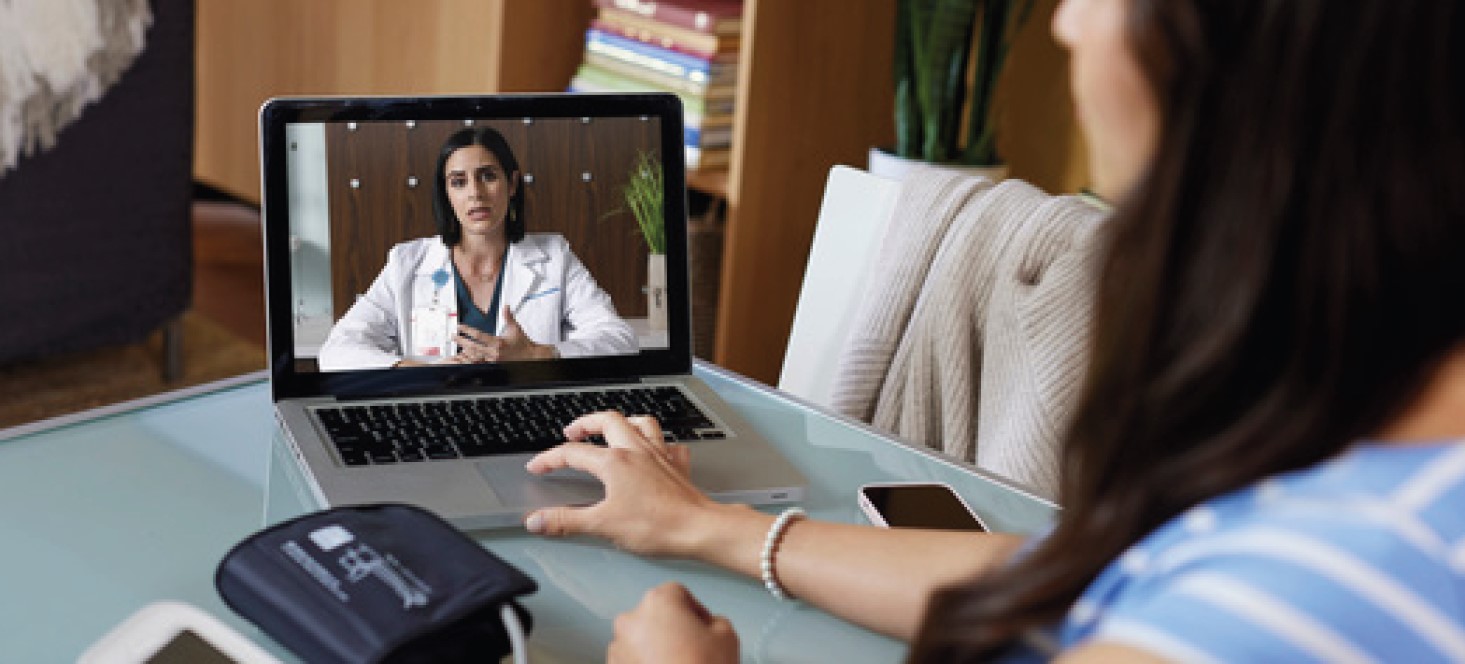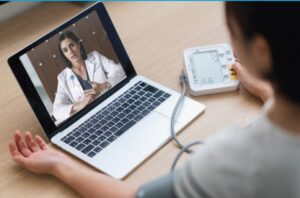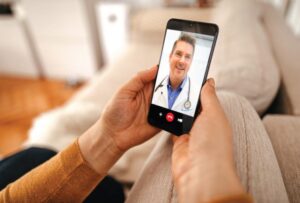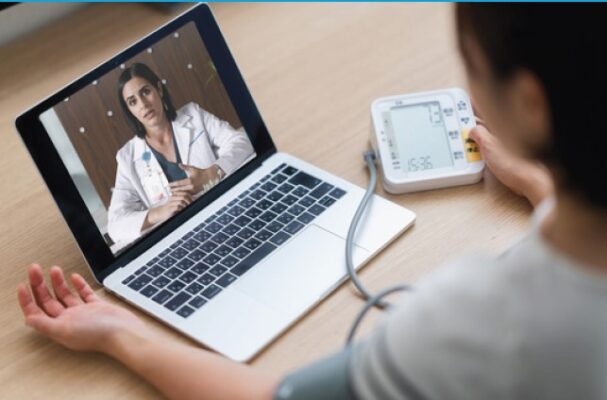Coaching and peer learning were the most valuable elements of the CCI program, participants said.

The Connected Care Accelerator: Equity Collaborative launched in April 2022 with an urgent mission: To expand safety net clinic’s ability to offer video visits with providers, especially because the federal government was considering a change in policy that would halt payments for phone visits.
The use of telehealth visits had soared during the pandemic, but even by 2022, audio-only visits were far more common than video calls. Our first iteration of the accelerator found that among participants, video visits made up only 10 percent of all health care visits, with behavior health calls accounting for less than 20 precent. With the government’s warning that it might stop payments for phone appointments entirely, clinics were scrambling to expand their video offerings.
With backing from Cedars-Sinai and the California Health Care Foundation, CCI helped clinics rapidly test, expand and share innovative strategies to increase equitable access to telehealth, especially video visits with providers. However, in September 2022 — about half way through the program, which ended in May 2023 — the federal government announced policy changes in Medi-Cal that preserved telehealth coverage and payments, including reimbursement parity for both phone and video visits. This reduced the urgency for participating health centers to roll out video visits, but for most of the clinics, work on telehealth expansion continued to flourish, according to the final report from Center for Community Health and Evaluation, part of Kaiser Permanente.
Among the report’s key findings:
1. In a push toward equity, health centers focused on patients who experienced digital barriers.
These tended to be older patients and patients who didn’t speak English or were more comfortable talking with providers in their own language. To figure out what was needed, clinic staff talked with patients about their experiences with telehealth and helped them fill out a baseline telehealth capacity assessment. Some providers were surprised to find that patients were more interested in video visits than they assumed.
 In the case of older patients who had computer issues, clinics arranged for help with digital services. For patients who preferred talking in a different language, clinics integrated interpreters into video visits and arranged for translations of patient education material that were also culturally appropriate. For example, Garfield Health Center developed flyers and posters for their waiting rooms on how to use the video platform in four different languages (English, Chinese, Spanish, Vietnamese), while Salud Para La Gente used call center nurses to guide patient through the telehealth process during intake. For translation services, Asian Pacific Healthcare Venture found an additional vendor made a huge difference: “Once we started implementing Doxy.me, it was a challenge because it would take 7-10 minutes to get an interpreter connected to the visit, which delayed our workflow. In the learning collaborative, we learned that Doxy.me had a vendor called VOYCE that provides interpreter services directly integrated with the platform. We just implemented that, so that has really helped our telehealth visits.”
In the case of older patients who had computer issues, clinics arranged for help with digital services. For patients who preferred talking in a different language, clinics integrated interpreters into video visits and arranged for translations of patient education material that were also culturally appropriate. For example, Garfield Health Center developed flyers and posters for their waiting rooms on how to use the video platform in four different languages (English, Chinese, Spanish, Vietnamese), while Salud Para La Gente used call center nurses to guide patient through the telehealth process during intake. For translation services, Asian Pacific Healthcare Venture found an additional vendor made a huge difference: “Once we started implementing Doxy.me, it was a challenge because it would take 7-10 minutes to get an interpreter connected to the visit, which delayed our workflow. In the learning collaborative, we learned that Doxy.me had a vendor called VOYCE that provides interpreter services directly integrated with the platform. We just implemented that, so that has really helped our telehealth visits.”
2. To improve equitable access, health centers ramped up staff training and refined workflows & technology.
Among the factors critical to success were leadership and provider buy-in, starting with a small pilot before scaling up, monitoring data, and seeking feedback from patients, providers and frontline staff By assessing their teams’ comfort with video visits, many also realized their providers and staff needed more training and support: San Joaquin County Clinics, for example, introduced a new telehealth platform that defaulted to use of video. As the report noted, “When the team transitioned to the new platform, they did live walkthroughs with staff to show them how to use it and how to troubleshoot common challenges. They started at about 5 percent of telehealth visits done by video, and by the end of their project, showed a rate of 11-16% of telehealth visits done by video, which also included a new [online] urgent care service line.”

To increase provider buy-in, another clinic agreed to accommodate provider preferences for video visits, whether they wanted a tablet, a desktop computer or one-sided headphones. And another health center noted: “Besides involving leadership, it’s also important to share the data with everyone in the clinic, whether that may be a nurse, an MA, registration staff. Because they all play key roles in this.”
3. The collaborative was successful in helping most of the clinics improve their virtual visit programs.
Out of the participating organizations, 13 out of 22 made progress on process or outcomes. The remaining six teams reported that the program had contributed to their telehealth push and provided valuable insights, but as one said, the staff turnover and a “too-short timeline” made it hard to accomplish their goals.” The teams felt their assignments were helpful, including patient and staff interviews, data reviews, the telehealth capacity assessment and a journey map, but several recommended a longer timeline for the next telehealth program.
4. For most participants, peer learning was the most highly rated part of the program.
Several clinics, in fact, suggested that the next CCA put an even greater focus on peer support and partnership building. “Peer sharing was to me, the most valuable, because [there] were moments where we could directly…ask what services, vendors, websites they were using and see what was most doable for us as a mid-sized FQHC. We [obtained] a script that was used in another organization as a best practice,” wrote one participant, who added that the peer sharing had improved their telehealth workflow and patient education.
 Another found the cohort’s partner sharing sessions invaluable. “We heard what they’ve been doing and what’s working well for them and what’s not working well for them — we take that into account. One of the things that we heard in the last sharing [webinar] was text visits for patients that are hard of hearing. It was one of those ‘a-ha’ moments, things that we can incorporate into our business.”
Another found the cohort’s partner sharing sessions invaluable. “We heard what they’ve been doing and what’s working well for them and what’s not working well for them — we take that into account. One of the things that we heard in the last sharing [webinar] was text visits for patients that are hard of hearing. It was one of those ‘a-ha’ moments, things that we can incorporate into our business.”
5. Coaching was a crucial support to help teams stay on track with project goals and deliverables.
Both individual and group coaching was highly rated, with some participants calling for more group coaching. “We have found a lot of value in hearing the experience of others, what they’re struggling with and how they have tackled it, as well as working with [our coach, who] really pushes us to think outside the box. Every working session that we have with her, it’s not just about completing the task, but really thinking about developing something realistic that will support our health system.”
Recommendations
The CCHE study made several recommendations to support equitable access to telehealth and video visits across the state, including:
- Developing a value proposition to build internal buy-in.
- Building in dedicated time and resources for telehealth, including infrastructure for video visits
- Continue to address disparities in access.
- Look for tech solutions, including seamless video translation, to problems that block access.
- Collecting and segmenting data on race and ethnicity, among other factors, to track progress on equity.
- Continue working to support patients who face digital barriers.
Find this useful or interesting? We’re constantly sharing stuff like this. Sign up to receive our newsletter to stay in the loop.

